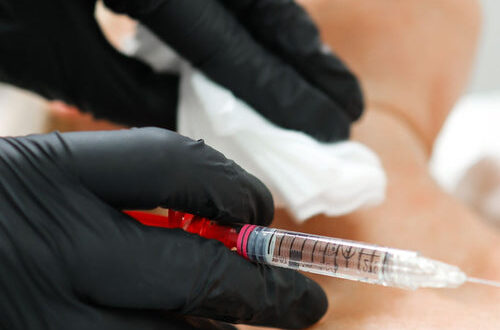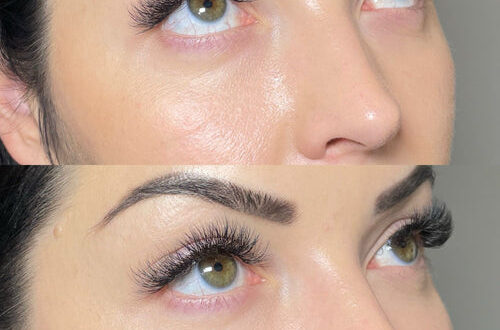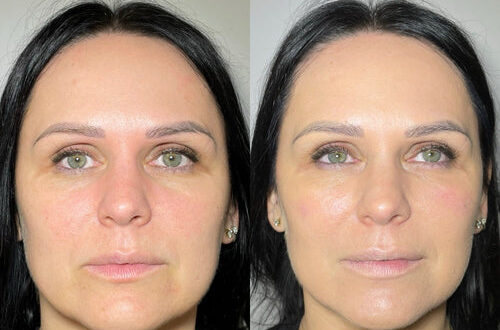Get a Dermal Filler Consultation with Dr. Laura Geige at It’s Me and You Clinic
Factors Affecting Longevity

Injection Technique
Longevity of dermal fillers, such as those used for temple augmentation, varies depending on several factors. These can be broadly categorized into individual-specific factors and injection technique.
Individual Factors:
Age: As we age, our skin’s collagen production naturally declines, leading to thinner skin and faster filler degradation.
Genetics: Some individuals have a genetic predisposition to quicker breakdown of injected substances.
Skin Type: Oily skin tends to metabolize fillers faster compared to drier skin types.
Lifestyle: Factors like sun exposure, smoking, and excessive alcohol consumption can accelerate filler breakdown.
Medical Conditions: Certain medical conditions or medications may influence filler longevity.
Injection Technique:**

Depth of Injection: Injecting too superficially can lead to faster filler migration and absorption. Precise placement in deeper layers promotes longer-lasting results.
Product Selection: Different fillers are formulated with varying compositions and molecular weights, impacting their longevity. Hyaluronic acid fillers tend to last around 6-18 months, while some longer-lasting options can persist for up to two years or more.
Spread of Filler: Even distribution of filler is crucial. Uneven spread can result in visible lumps or valleys, affecting both the aesthetic outcome and longevity.
Needle Size & Technique: Using an appropriate needle size and employing a smooth, controlled injection technique minimizes trauma to the surrounding tissue, potentially enhancing filler longevity.
Filler Type
Various factors influence the longevity of dermal fillers, such as hyaluronic acid (HA), which are commonly used for facial rejuvenation. Understanding these factors can help patients make informed decisions about their filler treatments and manage expectations regarding treatment duration.
Here are some key factors affecting filler longevity:
- Filler Type: Different fillers have varying lifespans due to their unique composition and how they interact with the body. HA fillers, for example, generally last 6 months to 2 years, depending on the product formulation and injection site.
- Injection Site: Fillers injected into areas of high movement or expression, like around the mouth and eyes, tend to degrade faster than those placed in less dynamic areas. This is because repeated muscle contractions can break down the filler particles.
- Patient’s Age and Skin Health: Younger individuals with healthy skin often experience longer-lasting results compared to older patients or those with compromised skin integrity. Collagen production naturally declines with age, affecting the structural support for fillers.
- Lifestyle Factors: Sun exposure, smoking, and excessive alcohol consumption can accelerate filler degradation. UV rays damage collagen fibers, while toxins from cigarettes and alcohol can impede skin health.
- Metabolic Rate: Individuals with faster metabolisms tend to metabolize fillers more quickly, leading to shorter-lasting results.
- Treatment Technique: **A skilled injector’s experience and technique play a crucial role in achieving optimal longevity. Proper placement, depth of injection, and volume distribution can maximize filler effectiveness and duration.
Book Your Dermal Filler Appointment with Dr. Laura Geige Now
It’s important to note that these factors interact with each other, making it difficult to predict the exact lifespan of any individual treatment. Regular consultations with a qualified aesthetic practitioner are essential for monitoring filler performance and addressing any concerns.
Individual Body Chemistry
Factors influencing the longevity of dermal fillers like Temple Filler are complex and multifaceted, extending beyond the mere product itself.
**Individual Body Chemistry:** Each person’s body possesses a unique biochemistry that plays a critical role in how fillers are metabolized and integrated.
Some individuals naturally break down substances more rapidly than others, leading to faster filler degradation. This can be influenced by genetics, metabolism, and overall health.
**Lifestyle Factors:**
Smoking is a significant factor as it constricts blood vessels, hindering the filler’s ability to integrate properly and reducing its longevity.
Sun exposure can also degrade fillers more quickly due to ultraviolet radiation’s impact on collagen and elastin.
Diet plays a role; proper hydration and a balanced diet support overall skin health, potentially prolonging filler effects.
**Product Characteristics:**
The type of filler used directly affects its longevity. Hyaluronic acid fillers, commonly used in Temple Filler, are generally reabsorbed by the body over time.
However, different hyaluronic acid formulations vary in their cross-linking density, which impacts how long they last. More densely cross-linked fillers tend to persist longer.
**Treatment Technique:**
A skilled injector’s technique significantly influences filler longevity. Proper placement, depth, and volume distribution are essential for optimal integration and lasting results.
**Skin Type & Thickness:**
Thicker skin may hold fillers longer than thinner skin due to a denser dermal layer.
It’s important to note that these factors interact in complex ways, making it difficult to predict precisely how long any individual filler will last. Consultation with a qualified and experienced injector is crucial for personalized assessments and realistic expectations.
Lifestyle Factors
Sun Exposure
Lifestyle factors play a significant role in how long dermal fillers, such as those used in temple augmentation, will last.
These factors can accelerate the breakdown of hyaluronic acid, the primary ingredient in most fillers.
- Sun Exposure: Excessive sun exposure is one of the biggest culprits in filler degradation. UV rays break down collagen and elastin, the proteins that support skin structure. This breakdown can lead to faster filler absorption and a shorter lifespan.
- Smoking: Smoking constricts blood vessels, reducing circulation and hindering the body’s ability to deliver nutrients to the treated area. This can impede the longevity of fillers.
- Diet and Hydration: A diet rich in antioxidants and a healthy intake of water contribute to skin elasticity and overall health, potentially prolonging filler results.
- Stress Levels: Chronic stress can increase inflammation and cortisol levels, both of which may accelerate filler breakdown.
- Skincare Routine: Using harsh products or neglecting sunscreen can damage the skin and affect filler longevity. Gentle cleansers, moisturizers, and broad-spectrum SPF are essential.
Minimizing sun exposure is crucial for maximizing filler results. Always wear sunscreen with an SPF of 30 or higher, even on cloudy days, and reapply every two hours, especially after sweating or swimming.
By adopting a healthy lifestyle that includes sun protection, avoiding smoking, maintaining proper hydration, managing stress levels, and using gentle skincare products, you can help your temple fillers last longer and achieve more sustained results.
Smoking
Lifestyle factors play a significant role in how long temple filler, like any dermal filler, will last.
Smoking is one lifestyle habit that can noticeably reduce the longevity of filler results.
Here’s why:
Nicotine in cigarettes constricts blood vessels, hindering blood flow to the treated area.
This reduced blood circulation impairs the body’s ability to deliver nutrients and oxygen necessary for collagen production and tissue regeneration.
Collagen is a crucial protein that provides structure and support to skin, making it firmer and more resilient.
Without sufficient collagen production, fillers break down faster and the effects diminish more quickly.
Additionally, smoking damages elastin fibers, another essential component of healthy skin that contributes to its elasticity and ability to bounce back.
Weakened elastin fibers lead to sagging and premature aging, further accelerating filler breakdown.
In essence, smoking creates a hostile environment for dermal fillers, accelerating their degradation and shortening their lifespan.
For individuals who smoke, temple filler may last up to 12 months, whereas non-smokers can expect results to last for 18-24 months or even longer.
Quitting smoking before and after treatment can significantly improve the longevity and effectiveness of temple fillers.
Facial Expressions
Schedule Your Dermal Filler Appointment with Dr. Laura Geige at It’s Me and You Clinic
Lifestyle factors can significantly influence how long dermal filler results last. While the average lifespan of temple fillers is around 12 to 18 months, individual experiences may vary.
Here are some lifestyle factors that can impact filler longevity:
- Sun Exposure: UV rays from the sun can break down hyaluronic acid fillers faster. Always wear sunscreen with an SPF of 30 or higher, even on cloudy days. Reapply every two hours, especially after swimming or sweating.
- Smoking: Nicotine constricts blood vessels, which can hinder blood flow to the injection sites and reduce filler effectiveness. Smoking also accelerates collagen breakdown, leading to faster filler degradation.
- Alcohol Consumption: Excessive alcohol intake can dehydrate the skin and weaken collagen fibers, making fillers less durable.
- Skincare Routine: Using harsh chemicals or scrubs on treated areas can irritate the skin and break down fillers prematurely. Opt for gentle cleansers and moisturizers designed for sensitive skin.
- Facial Expressions: Frequent and exaggerated facial expressions, such as frowning or squinting, can put stress on filler and accelerate its breakdown. While it’s natural to express yourself, being mindful of your expressions may help prolong results.
- Hydration:** Drinking plenty of water keeps skin hydrated and plump, which can enhance the appearance and longevity of fillers.
By adopting these healthy habits, you can maximize the lifespan of your temple fillers and enjoy their rejuvenating effects for longer.
Maintaining Results
Regular Follow-up Appointments
Maintaining the results of dermal filler treatments, such as those using Temple Filler, often involves a combination of lifestyle choices and follow-up appointments with a qualified practitioner.
Regular follow-up appointments are crucial for several reasons. Firstly, they allow the practitioner to assess how the filler is integrating with your natural tissues and ensure it’s positioned correctly. Over time, fillers can migrate slightly or settle differently, and adjustments may be needed to maintain a harmonious aesthetic.
Secondly, these appointments provide an opportunity to address any concerns you might have about the results. Perhaps you notice asymmetry, lumps, or changes in volume that weren’t present initially. A practitioner can identify potential issues early on and make necessary modifications to achieve optimal outcomes.
Thirdly, follow-up appointments help maintain the longevity of your filler results. While the exact lifespan of Temple Filler depends on various factors like the type used, individual metabolism, and lifestyle habits, regular top-ups can extend its effectiveness. During these appointments, the practitioner can strategically reintroduce filler to replenish areas where volume has naturally diminished.
The frequency of follow-up appointments will vary depending on several factors, including your individual needs and the specific type of Temple Filler used. However, a general guideline is to schedule an appointment every 6-12 months for touch-ups.
In addition to regular appointments, there are lifestyle choices you can make to prolong the effects of Temple Filler.
Avoiding excessive sun exposure is crucial, as UV rays can break down collagen and hyaluronic acid, leading to premature filler degradation.
Staying hydrated by drinking plenty of water helps keep the skin plump and supple, allowing the filler to distribute more evenly.
Eating a balanced diet rich in antioxidants can also contribute to maintaining skin health and supporting collagen production.
Skincare Routine
Maintaining the results of dermal fillers like those used for temple augmentation involves a combination of proper aftercare, lifestyle choices, and follow-up appointments.
Aftercare is crucial immediately following treatment.
- Avoid touching or massaging the treated area.
- Stay hydrated by drinking plenty of water.
- Refrain from strenuous activity and excessive sun exposure for at least a few days.
- Apply ice packs to reduce swelling as directed by your practitioner.
In the long term, adhering to a consistent *skincare routine* is essential to maintain youthful-looking skin and prolong filler results.
A comprehensive skincare regimen should include:
- Daily cleansing with a gentle cleanser suited for your skin type.
- Exfoliation 2-3 times per week to remove dead skin cells and promote cell turnover.
- Use of sunscreen daily, regardless of the weather.
- Moisturizing to keep the skin hydrated and plump.
Consider incorporating ingredients like *vitamin C* for antioxidant protection, *hyaluronic acid* for hydration, and *retinol* for collagen production into your skincare routine.
In addition to skincare, a healthy lifestyle plays a significant role in maintaining the longevity of filler results:
- A balanced diet rich in fruits, vegetables, and antioxidants supports skin health.
- Adequate sleep* promotes skin repair and rejuvenation.
- Managing stress levels* through relaxation techniques can minimize the negative impact of stress on collagen production.
Finally, it’s crucial to attend follow-up appointments with your provider as recommended. This allows for assessment of filler results, addressing any concerns, and determining the need for top-ups or adjustments to maintain optimal outcomes.
Minimizing Facial Trauma
Maintaining results from facial filler injections, particularly those targeting the temples, requires a multifaceted approach that prioritizes both product longevity and minimizing trauma to delicate facial tissues.
First and foremost, choosing the right type of filler is crucial. Hyaluronic acid (HA) fillers are commonly used for temple augmentation due to their ability to attract and hold water, providing volume and lift. Different HA fillers have varying levels of density and longevity. Discussing your desired outcomes and lifestyle with a qualified injector can help determine the most suitable option.
Proper injection technique plays a significant role in both effectiveness and minimizing trauma. Experienced injectors utilize precise placement strategies to ensure optimal distribution of the filler while avoiding unnecessary pressure or manipulation of surrounding tissues. Microcannulas, blunt-tipped needles with a larger lumen, are increasingly preferred for temple injections as they offer greater precision and reduce the risk of bruising and vascular compromise.
Post-injection care is equally important for maximizing results and promoting healing. Following your injector’s instructions meticulously regarding ice application, elevation, and activity restrictions can minimize swelling, redness, and discomfort.
Maintaining a healthy lifestyle also contributes to filler longevity. Staying hydrated, protecting your skin from sun damage with sunscreen, and avoiding smoking can all help preserve the results of temple augmentation. Additionally, certain medications, supplements, or medical conditions can affect filler breakdown. Open communication with your injector about any relevant factors is essential.
Over time, even the most well-placed fillers will gradually be metabolized by the body. Touch-up injections are typically required to maintain desired results. The frequency of these touch-ups depends on the type of filler used, individual metabolism, and lifestyle factors.
Cleveland Relationship Therapy En Bloch Hotels Crimson Hill Divine Magazine
- Forehead Frown Lines Treatment Near Thursley, Surrey - August 1, 2025
- Forehead Frown Lines Treatment Near Farncombe, Surrey - July 29, 2025
- Finding Affordable Baby Botox Treatments In Kingston Upon Thames - July 28, 2025


